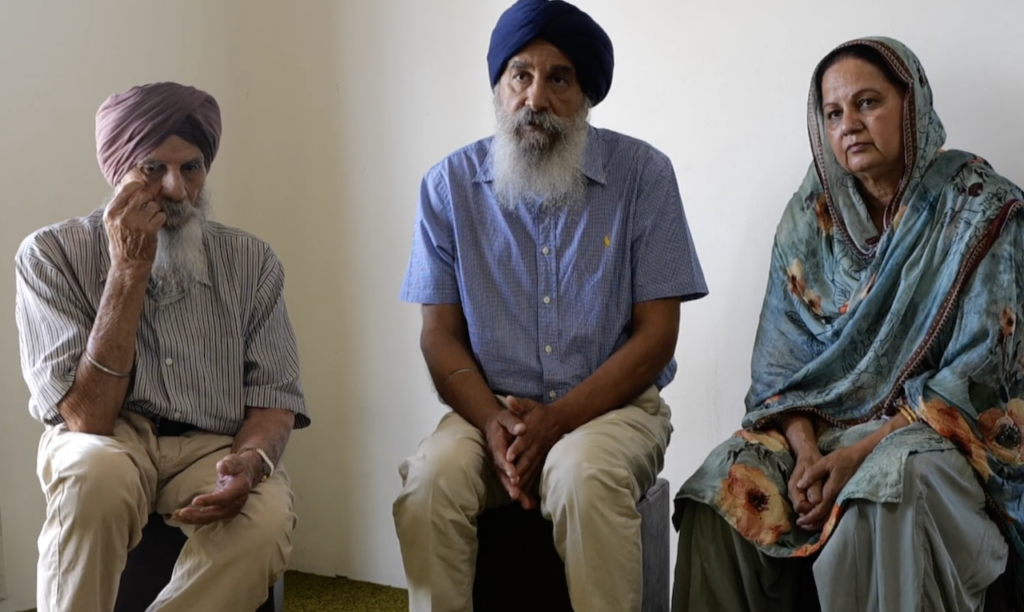The Bains family
Gian Singh Bains, his son Rajinder, and daughter-in-law Rasvinder discuss their family's history in Queensland. Gian helped establish Queensland's first Sikh gurdwara, at Edmonton south of Cairns, in 1983.
By Adam Bowles
This is a 5 minute read and 32 minute video, published December 2024.
In 1983, the Guru Nanak Sikh Temple was opened in Edmonton, a small township south of Cairns. This was Queensland’s first gurdwara, and the culmination of generations of Sikh presence in Far North Queensland. The land on which the Guru Nanak Temple was built was donated by Gian Singh Bains, a member of a family which had by then been established in Far North Queensland for three generations.
Gian’s grandfather, Sardar Mangal Singh, arrived from the Punjab — an area now divided between Pakistan and India — by ship in Perth in 1893 or 1894. He travelled to Victoria and worked as a hawker. Once he had raised sufficient capital, Sardar purchased farmland in Victoria and became a wheat farmer. After a number of years, Sardar Mangal sold his land and returned to the Punjab.
Federation in 1901 began to rapidly change the Australian social landscape under the restrictive and racist migration policies enforced by the White Australia Policy. Having unsuccessfully attempted to return to Australia in the early 1900s, Sardar Mangal travelled to the UK and then France with his brother, working predominately in coal mines. Discovering that people who had lived in Australia prior to 1901 were permitted to return, Sardar Mangal re-entered Australia in 1918, settling initially on the Atherton Tableland and working on dairy, corn, and maize farms, or clearing scrub to open up new farmland. Around the middle of the 1940s he moved with his son — who had by now joined him — to the Cairns region and began working in the cane industry.
Family connections: India to Australia
Like other migrants from non-European backgrounds, Sikhs were restricted in their capacity to move their families to Australia. The menfolk typically returned to their homelands to visit wives and children, only returning with their eldest sons once they had reached working age.
Such was the pattern followed by Sardar Mangal Singh. In 1925 he visited the family’s village of Bilga, in the Jalandhar district of the modern Indian state of Punjab, and returned to Australia with his twelve-year-old son, Sardar Daleep Singh. He would come to be known as ‘Don’. In the Second World War Sardar Daleep served in the Volunteer Defence Corps. Like his father, Sardar Daleep would also return for periods to the Punjab. In 1934 his son, Gian Singh Bains, was born in what is today Pakistan, though his family moved to Bilga before the partition of British India at Independence in 1947. Gian came to Australia with his father in 1951 at the age of 17.
Sardar Mangal and Sardar Daleep were absent from their children and wives for long periods of time, as was common for migrant families from non-European backgrounds. Their families only saw them on their brief returns to India. Much of Gian’s knowledge of his father, Sardar Daleep Singh, came from stories told to him by his grandfather, Sardar Mangal Singh, who had returned to India to live after his retirement.
In 1958, this pattern would change. Sardar Daleep’s wife, Gian’s wife, and Gian’s eldest daughter were permitted to migrate to Australia. Gian’s sisters, who had already married, remained in India. In December 1958, Rajinder Singh Bains was born in Gordonvale, the first generation of their family to be born and raised in Australia.
A community centre: building the gurdwara
In the Cairns region, the Bains family joined other Sikh families, some of whom had been in the region since the 1890s. They also typically worked in the cane fields. Many families, including the Bains, became landowners.
In the absence of formal structures, Sikh traditions were maintained within families. Rajinder was taught Punjabi and Gurmukhi by his parents. For shared practices and events, such as readings from the Guru Granth Sahib, the singing of kirtans, langar, or weddings, the community would gather in each other’s houses. By the late 1970s, the community had grown to the point that they began to hire local halls for these purposes. Momentum was gathering for the building of a gurdwara, the Sikh temple space used for the care and reading of the Guru Granth Sahib, for the singing of devotional songs (kirtan), and for community gatherings.
According to Rajinder, his father was approached by the community to donate a portion of his farmland that was adjacent to the highway. Rajindar Chohan, another member of the Cairns Sikh community whose family has lived in the area since 1894, indicated that the land had been the site of a cane cutters’ barracks. Visibility is an important consideration for the location of gurdwaras. For similar reasons, flying high above every gurdwara is a flagpole bearing the Nishan Sahib. The visibility of gurdwaras, as places of community and refuge for Sikhs, enables their discoverability and invites allcomers to visit them and participate in community life.

Figure 3: Guru Nanak Sikh Temple, Edmonton, 1983 (Gian Singh Bains centre right) (National Archives of Australia).
With a site established, other members of the Sikh community contributed donations and participated in fundraising, leading to the design and building of the gurdwara. Generosity (dan) and service (seva) are important Sikh virtues, of which the building and maintenance of gurdwaras are an expression. These virtues continue to inform community participation. Members donate food for the practice of langar and their time for gatherings and services. Community raised funds support a Granthi, who cares for the Guru Granth Sahib and leads in its reading, the first of whom started in 2016.
Jasvinder Kaur Bains, Rajinder’s wife, who arrived in 1981 just before the gurdwara was built, emphasised how important the Edmonton Gurdwara has been as a place of gathering for the women within the community and as a place for the children to form friendships. The gurdwara has become an important community gathering place and a symbol of the Sikh contribution to the social landscape of Far North Queensland, which now has four gurdwaras — in Gordonvale (built in 1984 not far down the highway from Edmonton), Townsville, and Innisfail.
The story of the Bains family is emblematic of the twentieth century migrant experience in Queensland. The tentative footholds established in seeking economic opportunity and adventure, often in the face of jurisdictional hostility, led gradually to consolidation, and then, with increasing prosperity, to local expressions of traditional community establishments, such as gurdwaras.
Oral history interview: the Bains family
Related articles




